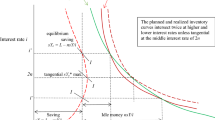Abstract
The purpose of this paper is to investigate the economic interpretation of the “no-black-hole” condition (NBHC) described in the Chapt. 4 of the book by Fujita, Krugman and Venables (1999), under the context of a more general model. The main findings are as follows. First, there is the case in which the NBHC does not hold even though the real wage falls at the symmetric equilibrium. Secondly, the NBHC in the more general model requires both a reduction in profits in response to an increase in the number of firms and a fall in the real wage rate in response to an increase in labor at the symmetric equilibrium. Thirdly, we show that NBHCs obtained in some analyses are special cases of our model. Moreover, we show that the NBHC includes the stability condition for the short-run equilibrium. Therefore the NBHC is not affected by relative speed of labor movement and entry/exit of firms.
Similar content being viewed by others
Author information
Authors and Affiliations
Corresponding author
Additional information
Received: November 2002/Accepted: March 2004




